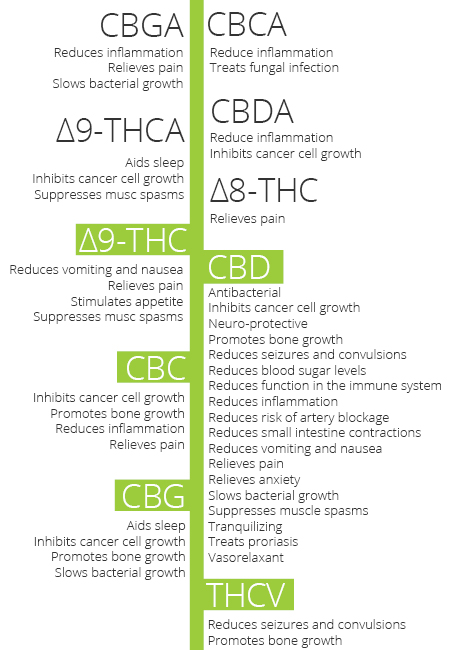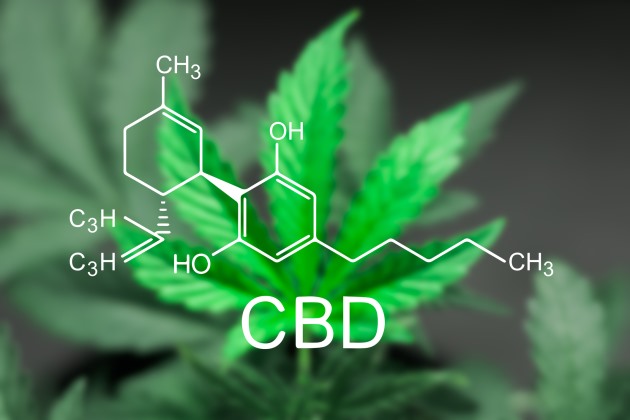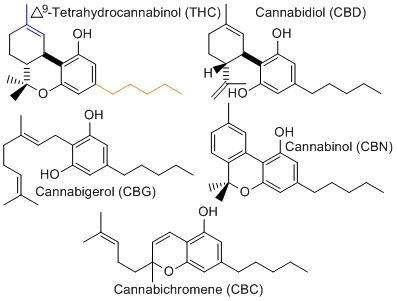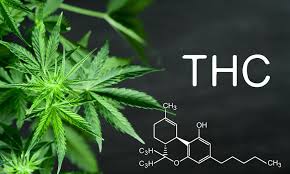CBD isn’t the only cannabinoid on the block with substantial health benefits.

You’ve heard all about CBD. CBD comes in many forms: isolate, full-spectrum and broad-spectrum. Let’s get to know those other cannabinoids working alongside CBD in the full spectrum and broad-spectrum products, and their medicinal benefits, also.
Phytocannabinoids are naturally occurring chemical substances that interact with receptors in the brain. They occur naturally in the cannabis plant. Classical cannabinoids are formed through decarboxylation of their respective 2-carboxylic acids, a process that is catalyzed by heat, light, or alkaline conditions. Some phytocannabinoids are active until heated. Phytocannabinoids are chemical compounds, a group of terpene phenolic compounds concentrated in the viscous resin of the glandular trichomes on the plant bud. They act directly and indirectly with the body with endocannabinoid receptors to help the body maintain stability, health, and homeostasis.
Cannabinoids have their own unique responsibilities. Some are responsible for the main effects of cannabis while others have important medicinal benefits. All cannabinoids present in cannabis are in their acidic form, such as THCA and CBDA. The acid form has a much lower potential for psychoactivity. These cannabinoids undergo decarboxylation during consumption (combustion, vaporizing, cooking) which transforms it into its active form of THC, CBD, or other cannabinoids, with the action of heat. Cannabinoids are soluble in oil and organic solvents, but very little in water.
Our bodies are full of receptors that interact with cannabinoids. Our bodies also make their own endocannabinoids to work on cannabinoid receptors. Cannabis and other plants produce cannabinoids that interact with our receptors. These plant cannabinoids are phytocannabinoids, and just one of the cannabis plants active ingredients. Terpenes and flavonoids also play an important role.

Studies have shown the hundreds of benefits of different cannabinoids, and some benefits are enhanced when the cannabinoids are able to work together. All cannabinoids come from their precursors CBGA and CBGVA. CBGA (cannabigerol acid) converts to THCA and CBDA as the cannabis plant develops, so it is found only in tiny amounts in the mature plant. Through photosynthesis, CBGA is produced, which then converts to THCA, CBDA, and CBCA through various chemical processes within the raw cannabis plant. When harvested cannabis is heated, the remaining CBGA converts directly to CBG. CBGA may be the building block for everything else within the cannabis plant, but it still does its job of its medicinal and therapeutic properties.
Now let’s get to know some of the main cannabinoids that I have gotten to know through researching various scientific studies. Let’s start with CBGA since it is the stem cell for all other cannabinoids.
- CBGA- Cannabigerolic Acid: Precursor molecule to THCA and CBDA, converting as the plant develops. Found only in tiny amounts in the mature cannabis plant. In the harvested plant, the remaining CBGA converts to CBG with exposure to light and air. CBGA is produced by the cannabis plant through photosynthesis. CBGA becomes THCA, CBDA, and CBCA through various chemical processes within the raw cannabis plant. Heated harvested cannabis converts the remaining CBGA to CBG. Medical benefits: Analgesic, anti-inflammatory, antibacterial, pain reliever, and has been shown to slow bacterial growth.
- CBGV- Cannabigerovarin: CBGV is produced by Cannabis along with other acid forms of cannabinoids as a survival mechanism, providing the cannabis plant with insecticidal defenses and increased resistance to plant diseases. In order or CBGV to be converted by the body into usable CBD, CBGV must first undergo a decarboxylation process. It is one of the many cannabinoids that are ineffective until heated. Medical: Kills cancer cells, anticonvulsant. CBDV is to CBD what THCV is to THC.
- CBG- Cannabigerol: CBG is present at very low levels (less than 1%) in most cannabis strains. To obtain higher yields of CBG, breeders are experimenting with genetic manipulation and cross-breeding of plants. Scientists can extract higher CBG levels from budding plants by pinpointing the ideal extraction time (6 weeks into an 8-week flowering cycle). CBG is the precursor of THC and CBD. Medical benefits: Anti-depressant, muscle relaxant, antibiotic, antifungal, blood pressure reducer, inhibits cancer growth, bone-stimulant, anti-inflammatory, antibacterial, aids sleep, anti-anxiety, arthritis, bipolar, OCD, PTSD, Alzheimer’s, Parkinson’s, spasticity, osteoporosis, ALS, glaucoma, muscular dystrophy, and cancer.

- CBDV- Cannabidivarin: CBDV is found more in indica strains, specifically landrace strains and strains lower in THC. Medical benefits: anticonvulsant, reduces nausea, reduces inflammation, beneficial in the treatment of pain and mood disorders, effective in providing symptoms of relief for seizures, Crohn’s disease, HIV/AIDS, and Multiple Sclerosis.
- CBDA- Cannabidiolic Acid: CBDA is the acidic parent found in the raw cannabis plant. CBDA converts to CBD through heat exposure or time. Finding CBDA can be touch because most extractors decarboxylate extracted cannabinoids to activate them. CBDA is found in mature hemp or marijuana ready to be harvested. Low temp juicing process extracts raw compounds that are sold directly or commonly blended with heated extracts. Blended unlocks a higher entourage level! CBDA to CBD 1:1 is becoming more popular. Medical benefits: non-psychoactive, reduces nausea, kills cancer cells, inhibits cancer cell growth, reduces inflammation, arthritis, reduces symptoms of cancer, anti-anxyiolytic, anti-emetic, antioxidant, and antiproliferate.
- CBD Cannabidiol: I know I did a whole blog about this particular cannabinoid, but let’s throw in some facts while we are talking about its friends here. CBD is non-psychoactive and enhances the inhibitory effects of THC on glioblastoma cell proliferation. CBD makes THC more potent as an anti-cancer substance. CBD stimulates neurogenesis and is a neuro-protectant. CBD mimics and augments the effects of the endocannabinoids. By modulating the endocannabinoid system and enhancing endocannabinoid tone, THC and CBD can slow or stop disease progression. Medical: inhibits cancer and tumor growth, pain relief, appetite stimulant, antioxidant, muscle relaxant, reduces nausea and vomiting, spasticity, insomnia, anti-anxiety, antibacterial, promotes bone growth, anticonvulsant, epilepsy, reduces blood sugar, anti-inflammatory, reduces risk of artery blockage, osteoporosis, reduces small intestine contractions, vasorelaxant, psoriasis, cramps, stress, migraines, phantom limb, fibromyalgia, anorexia, gastrointestinal disorders, diabetes, Crohn’s disease, PTSD, Parkinson’s, Alzheimer’s, muscular dystrophy, multiple sclerosis, ALS, ADHD/ADD, Bipolar disorder, and OCD.

- CBL- Cannabicyclol: CBL is one of the lesser-known and studied cannabinoids. CBL is found in varieties with higher CBC content. The amount of CBL produced in trichomes is always very low and doesn’t receive the attention given to other, more noticeable presence such as THC, CBD, or CBN. CBL comes from the degradation of CBC, mainly through the action of light. When CBC is subjected to oxygen or UV light, CBL is obtained. The plant produces very small amounts of CBLA (CBL’s acidic form). CBL is difficult to decarboxylate being the most resistant cannabinoid to this process, so getting active CBL from CBLA is complicated. Medical benefits: anti-tumor, anti-inflammatory.
- CBCA- Cannabichromenate: CBCA is produced by CBGA in raw cannabis plants. CBCA produces cannabinoids CBC, CBL, and CBLA when heated or aged. Like CBDA and THCA, CBCA is the parent cannabinoid of CBC. Medical benefits: Antifungal, anti-inflammatory.
- CBC- Cannabichromene: CBC is found only in tiny amounts in the cannabis plant. One of the “big six” cannabinoids prominent in medical research. CBC stems from CBGA. When CBC activates receptors TRPV1 and TRPA1 it increases the body’s natural endocannabinoids like anandamide to be released. CBC is healthy for brain function. Medical benefits: Inhibits cancer growth, promotes bone growth, inhibits tumor cell growth, anti-inflammatory, antibacterial, pain reliever, sleep aid, arthritis, anti-depression, Alzheimer’s, Parkinson’s, osteoporosis, ALS, muscular dystrophy, cancer, acne, suppresses sebaceous glands excessive production.

- CBN- Cannabinol: CBD is the breakdown product of THC through the aging of harvested cannabis. CBN is known to be potentially useful for aiding sleep, good for reducing pain and muscle spasms as well. Oxidization converts THC to CBN. CBN can be more present in aged or badly stored cannabis, as it has been more exposed to oxygen. CBN has a whole host of medical benefits considering it is more present in cannabis that isn’t fresh or wasn’t stored well. Medical benefits: pain reliever, sleep aid, relieves spasms, fibromyalgia, insomnia, arthritis, inflammation, depression, epilepsy/seizures, Multiple Sclerosis, spasticity, osteoporosis, ALS, antibacterial, appetite stimulant, bone cell growth, psoriasis, eases growth of skin tissue.
- THCV- Tetrahydrocannabivarin: THCV has psychoactive properties but they are much less than THC. THCV has been found to suppress the appetite, aiding in weight loss. THCV has antiseizure effects. Strains or products rich in THCV may result in stimulation, clear-headed, almost psychedelic type of energetic high that’s typically shorter in duration. THCV binds with both CB1 and CB2 receptors. THCV is found more abundantly in sativas, particularly landrace strains. Medical benefits: reduces blood sugar, reduces seizures, bone-stimulant, anticonvulsant, epilepsy, pain reliever, diabetes, osteoporosis, anti-anxiety, PTSD, antioxidant, anti-inflammatory, reduces insulin sensitivity, regulate glucose levels, therapeutic potential to treat schizophrenia, possibly help glucose intolerance that is obesity-related.
- THCA- Tetrahydrocannabinolic Acid: THCA is the acidic parent of THC and is found in raw cannabis. It is non-psychoactive and doesn’t activate CB1 cannabinoid receptors in the brain. THCA has the ability to work in low doses. Medical benefits: reduces seizures, nausea, muscle spasms, fights tumor and cancer cell growth, aids sleep, suppresses muscle spasms, aids arthritis, epilepsy, multiple sclerosis, Alzheimer’s, Parkinson’s, spasticity, HIV/AIDS, and cancer.

- THC- Tetrahydrocannabinol: THC is the principal psychoactive constituent of cannabis. Cannabis doesn’t actually produce THC or CBD. The plant produces all cannabinoids in an acid form. Instead of making THC and CBD directly, it synthesizes THCA and CBDA from their CBGA precursors. Medical benefits of THC: pain reliever, increases appetite, relieves spasms, antioxidant, muscle relaxant, reduces nausea and vomiting, aids with sleep apnea, cramps, migraines/headaches, phantom limb, spinal injury, fibromyalgia, insomnia, arthritis, inflammation, anorexia, cachexia, gastrointestinal disorders, Crohn’s disease, ADD/ADHD, stress, bipolar disorder, OCD, PTSD, Tourette’s, Multiple sclerosis, Alzheimer’s, Parkinson’s, spasticity, Amniolateral Sclerosis, fatigue, asthma, hypertension, glaucoma, HIV/AIDS, muscular dystrophy, cancer, and depression.
Other, less well-studied cannabinoids include:
- THCVA, CBDVA, and CBCVA: occur in raw cannabis.
- CBGVA: related to CBGA
- CBCV and CBGV: produced when cannabis is heated
- CBNA, Delta-8-THC, CBL, and CBLA: produced through aging.
The benefits of these cannabinoids are largely unidentified but the C-variations all contain anti-inflammatory properties. Delta-8-THC, like its T-based brother, has been known to have anti-anxiety and anti-nausea effects.

Those are just the phytocannabinoids that occur in the cannabis plant. There are also endocannabinoids your body produces that interact with these cannabinoids.
With the hundreds of disorders and diseases that these cannabinoids can ease the symptoms of or even obliterate, it is crucial to continue studying as much about these plant compounds as possible. This plant has the key to unlock the power to treat conditions doctors have been scratching their heads at for years and continuing to push prescription meds. Cannabis is a safer, natural alternative and holds much more potential with almost zero side effects. It truly will enhance your quality of life if given the chance.

As you can see, many cannabinoids help combat the same conditions, maximizing healing and therapeutic benefits. Whole plant working together can be greater than the sum of its parts.
For more information please visit us at steelcitycbd.net or shoot us an email at thesteelcitycbd@gmail.com.